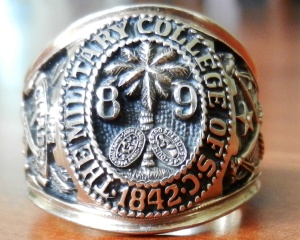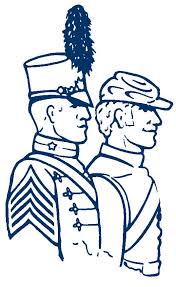I wear the ring
For a Citadel graduate, the band of brotherhood formed and embedded in the course of four long years is both figurative and literal. It is intrinsic and personal as well as concrete and visible. What is known to many as “the band of gold”, The Citadel ring is instantly recognizable and marks its wearer as a Citadel Man, or since 1999, Woman. It is standardized yet unique, and it is distinguishable from all other college rings. There are no others like it, and, as far as Citadel alumni are concerned, there will never be.
Pat Conroy, Class of 1967, immortalized the sentence “I wear the ring.” in his novel The Lords of Discipline published in 1980. The book was made into a film released in 1983, and I entered the college as a freshman “knob” in August 1985. I had watched the movie before arriving on campus, but I had not read the book. Although everyone had recommended it as a must read, I had not wanted to distort my mental picture of The Citadel, or worse, scare myself into thinking I had made a very bad decision. I should not have wasted energy on such trivial contemplations. The cadre quickly provided to me its own picture of life at The Citadel. I was confronted with a stark reality – knob year was not going to play out like in the movie. It was, at times, going to be much more terrifying, but, as the cadre would like to frame the experience for us, in a positive, character building kind of way. In the Fall of 1988 after having survived knob year and then another two academic years, I was, like the rest of my brothers of the class of 1989 and all the Citadel Men before us, eager and ready to receive my “band of gold”.
For the young men at the college in the early 1940’s, the sentiments attached to the ring were no different; however, as they were preparing for war how they received their rings was very different. From the school’s archives, I learned that the sophomore class in the 1942-1943 academic year was given a ring with no numerals.[1]
The Citadel ring was the ultimate prize. Like all those before and since, the fourth classmen of 1940 craved their graduation rings. But The Citadel’s training was and is to prepare soldiers to serve their country.
“The Enlisted Reserve Corps [ERC] told us we would get to graduate, just not when,” says class [1944] member Bob Adden.
At the end of their junior year, the Class of ’43 recommended to Summerall that the Class of ’44 receive their class rings early. The general approved. What was so important about The Citadel ring? “Everything!” says Sam Collins, the Kentucky classmate.[2]
Related: The 70th Anniversary of the Class of 1944
The classes of the early 1940’s gave their school and country so much. I have found something else they bestowed on the long gray line – the fact that it is possible to spot the ring from a mile away.
“The Citadel ring was standardized in 1940 by the Ring Committee with the approval of the Classes of 1940, 1941, and 1942. Standardization brings two distinct advantages. First, it makes The Citadel ring easy to recognize, since all graduating classes wear the same type of ring, and secondly, it denotes not a member of a certain class, but a Citadel graduate.”[3]
In his commencement address to the Class of 2001, Pat Conroy shared this, “In 1979, the year most of ya’ll were born, I was finishing up The Lords of Discipline and I tried to think of a line or words that would sum up better than anything how I felt and how other people feel about this college. I wanted it to be something ringing and affirmative, something true, something to be true for every person who has ever gone through the long gray line. I came up with this line, “I wear the ring.””[4]
A sentence of but four words – simple yet omniscient – when you wear the ring.
In fifteen WWII American Cemeteries of Europe and North Africa and two British Commonwealth cemeteries, 56 Citadel Men rest in peace or are remembered on the Tablets of the Missing. They, too, aspired to wear THE RING. We shall not forget them.

Visitors to Normandy American Cemetery stop at the grave of Captain Clough Farrar Gee, III, U.S. Army Air Corps, Class of 1939. CPT Gee was killed in action on D-Day +1 while providing close air support to the Allies pushing inland from the Normandy beachhead.
/RL
[2] “The Citadel Class That Never Was”, Shelia Collins Ingle, Sandlapper Autumn 2009, https://www.sandlapper.org/magazine/archives/autumn_2009/
[3] The South Carolina Corps of Cadets, The Guidon 2011-2012, p. 85, https://www.citadel.edu/root/images/Academic_Affairs/guidon.pdf
[4] Pat Conroy, Commencement Address to The Citadel Class of 2001, 12 May 2001, https://externalaffairs.citadel.edu/conroy


Fantastic! Romeons 89
Bravo Zulu
Bert Scott
’89
Well done Roger. Sublime.
Bob Charland ’89
Excellent!
Vince Williams ’89
Very good!
Rick Young ’89
Good stuff!
Sean Egnew
Alpha ’89
Reblogged this on Mastermind Century Group and commented:
Great post…
Once again the class of ’89 is leading the way. Thanks for being ‘my’ cadre corporals.
Sandy Key ’90
Thank you for this post!
Clay Ludlum
Class of 1990
Nice!
Carey Livingston
Class of 1985
Reblogged this on The Citadel Memorial Europe and commented:
A rerun of our most popular post. In honor of the Class of 2013 who receive The Ring today and for all the parents, alumni and family who will be visiting The Citadel this Parents’ Day Weekend. Class of 2013 uphold the ideals of The Citadel and never forget those who have gone before you.
Very Good. I had “difficulties” while attending The Citadel. let’s just say that my attitude was not all there and that I was unhappy. Messed up academically, 1st semester Knob year and was thrown a semester behind my class. Even by Jr. year, my attitude wasn’t great and I was s till unhappy. I wasn;t even going to buy the Ring, but my Great Aunt sent me the $350 (1983) and told me to purchase it, anyway, which I did. I did not attend the Ring Ceremony because I was behind. I do not remember exactly how i received it. Classmate John Riley insist that I put it on. I did, then took it off. I sent it to my Great Aunt, who placed it in her top dresser drawer, where it stayed for 5 years after my graduation. My attitude changed after those 5 years and I finally asked Aunt Virginia for my Ring. I have worn it ever since, with pride. As I now have grown older….wiser, if you will….I have become even more filled with pride to our college endure and realize that I….I am a part of it. I accomplished a great feat, under harsh conditions, of which I am immensely proud……I Wear the Ring! Class of 1984